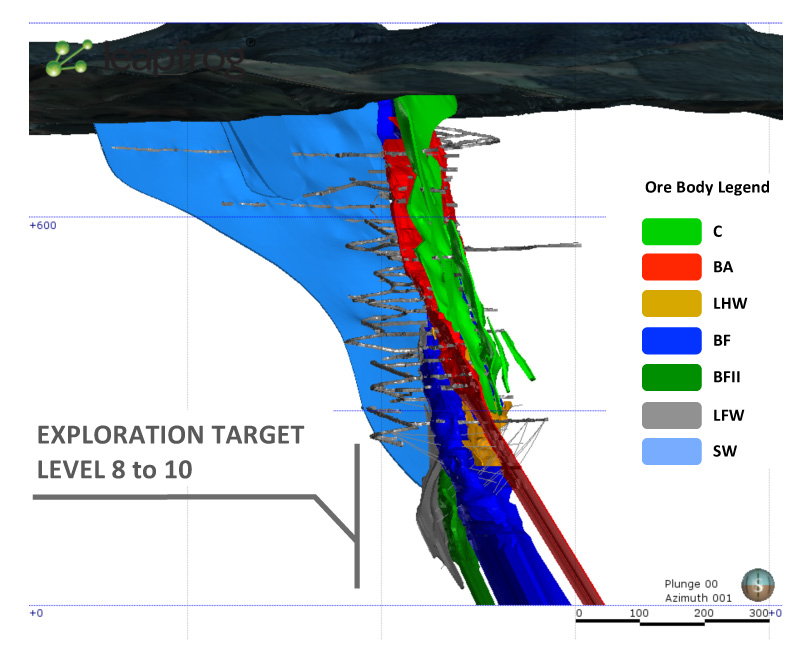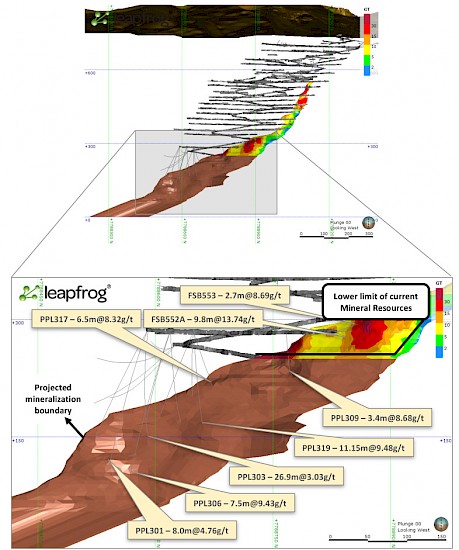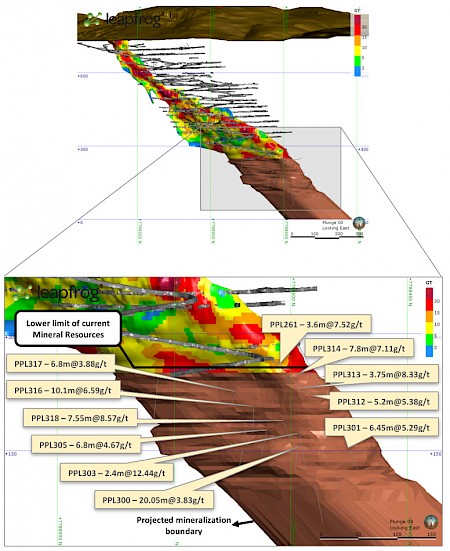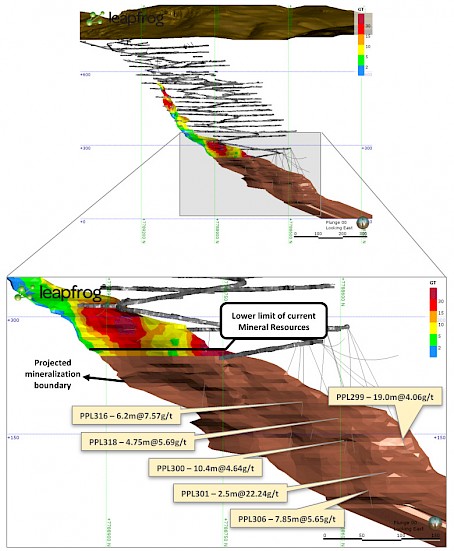Toronto, Canada, August 17, 2015 - Jaguar Mining Inc. ("Jaguar" or the "Company") (JAG: TSX-V) today announced the final set of exploration drill results from the 2015 exploration program at the Pilar Mine, located in Minas Gerais, Brazil. These results include additional high-grade gold intercepts from the latest round of underground exploration drilling. The most significant high-grade gold results from this drilling campaign come from BFII and BF at the footwall of ore body BA and in particular, drill hole FSB552A with 13.74 grams per tonne Gold ("g/t Au") over 9.8 meters and drill hole PPL 319 with 9.48 g/t Au over 11.15 meters. (Intersections do not represent true thickness and have been drilled from drill platforms aiming to intersect the mineral resources perpendicular to the plunge and dip of the projected mineralization as possible.)
The Pilar Mine is one of two underground mines that provide ore to the Caeté Mill Complex ("Caeté") and this production currently represents approximately two-thirds of the ounces produced at Caeté.
This 2015 drilling program, initially launched in late Q3 2014, was largely focused to test potential depth extensions of mineralization below level 7 at the Pilar Mine. This program was projected to intersect the mineralization at levels 8, 9 and 10 (figure 1), covering a vertical length of 240 meters (80 meters per level).
The program included 31 diamond drill holes for a total of 6,541 drilled meters. Drill holes were planned along the extensions of existing pay shoots and targeting a grid of 40 x 40 meters. About 80% of drill holes were projected to intercept the mineralization from the hanging wall (average N223 dipping 51o) and 20% to intercept the mineralization from the footwall (average N76 dipping 18o). Average depth per drill hole was 211 meters.
High-grade intercepts reported in Table 1 confirm the depth extensions of the mineralized system at the Pilar Mine. In addition, these results show higher continuity, grade and thickness of the mineralized zones BFII and BF at levels 8, 9 and 10. Ore body BFII shows high-grade results in both the upper and lower limbs while higher grade results are in the lower limb of ore body BF. Ore shoots where the higher grades are concentrated follow the hinge zones of the anticlines.
George Bee, Chief Executive Officer of Jaguar commented: "The Pilar Mine has been subject to a lack of investment in exploration and development as a result of financial constraints. The geology is quite complex and understanding the structural controls is essential. In 2015, we funded a limited program and undertook the exploration in the belief that Pilar and our surrounding claims held potential. These drill results are very exciting and clearly confirm the potential of mineral resources and reserves at the Pilar Mine below level 7, a level currently being mined. These intersections also clarify some geological features and the understanding of mineralization controls that will enable a broader exploration program when further funding becomes available."
Key intercepts includes drill hole FSB552A with 13.74 g/t Au over 9.8 meters, drill hole PPL 319 with 9.48 g/t Au over 11.15 meters, drill hole PPL287 with 5.07 g/t Au over 16.45 meters, drill hole PPL314 with 7.26 g/t Au over 9.25 meters, drill hole PPL316 with 6.59 g/t Au over 10.10 meters, drill hole PPL318 with 8.57 g/t Au over 7.55 meters, drill hole PPL 306 with 9.43 g/t Au over 7.5 meters, including 22.32 g/t Au over 2.70 meters.
Table 1 - Drill hole intersections at Pilar Mine
| Hole ID | Ore Body | From | To | Length (m) | Au ppm | Elevation |
|---|---|---|---|---|---|---|
| PPL261 | BF | 70.40 | 74.00 | 3.60 | 7.52 | 262 |
| PPL287 | BFII | 110.50 | 126.95 | 16.45 | 5.07 | 302 |
| PPL299 | BFII | 203.50 | 222.50 | 19.00 | 4.06 | 142 |
| Including | BFII | 203.50 | 210.35 | 6.85 | 6.93 | 142 |
| PPL300 | BF | 163.35 | 183.40 | 20.05 | 3.83 | 162 |
| PPL300 | BFII | 197.60 | 208.00 | 10.40 | 4.64 | 144 |
| PPL301 | BF | 203.40 | 209.85 | 6.45 | 5.29 | 124 |
| PPL301 | BFII | 211.40 | 219.40 | 8.00 | 4.76 | 119 |
| PPL301 | BFII | 243.70 | 246.20 | 2.50 | 22.24 | 99 |
| PPL303 | BF | 151.20 | 153.60 | 2.40 | 12.44 | 176 |
| PPL303 | BFII | 166.50 | 193.40 | 26.90 | 3.03 | 159 |
| PPL305 | BF | 136.10 | 142.90 | 6.80 | 4.67 | 180 |
| PPL306 | BFII | 213.20 | 220.70 | 7.50 | 9.43 | 100 |
| Including | BFII | 218.00 | 220.70 | 2.70 | 22.32 | 100 |
| PPL306 | BFII | 239.35 | 247.20 | 7.85 | 5.65 | 79 |
| PPL309 | BFII | 48.40 | 51.80 | 3.40 | 8.68 | 236 |
| PPL312 | BF | 108.35 | 113.55 | 5.20 | 5.38 | 217 |
| PPL313 | BF | 89.30 | 93.05 | 3.75 | 8.33 | 228 |
| PPL313 | LPA | 99.15 | 102.05 | 2.90 | 12.31 | 224 |
| PPL314 | BF | 87.00 | 96.25 | 9.25 | 7.26 | 247 |
| PPL314 | BF | 115.30 | 123.10 | 7.80 | 7.11 | 245 |
| PPL316 | BF | 99.60 | 109.70 | 10.10 | 6.59 | 211 |
| PPL316 | BFII | 131.10 | 137.30 | 6.20 | 7.57 | 193 |
| PPL317 | BF | 91.90 | 98.70 | 6.80 | 3.88 | 228 |
| PPL317 | BFII | 112.00 | 118.50 | 6.50 | 8.32 | 218 |
| PPL318 | BF | 122.95 | 130.50 | 7.55 | 8.57 | 192 |
| PPL318 | BFII | 154.65 | 159.40 | 4.75 | 5.69 | 172 |
| PPL319 | BFII | 135.20 | 146.35 | 11.15 | 9.48 | 158 |
| FSB553 | BFII | 26.80 | 29.50 | 2.70 | 8.69 | 293 |
| FSB552 A | BFII | 18.80 | 28.60 | 9.80 | 13.74 | 275 |
| FSB551 | BFII | 29.90 | 33.60 | 3.70 | 10.12 | 284 |
Intersections do not represent true thickness and have been drilled from drill platforms aiming to intersect the mineral resource as perpendicular to the plunge and dip of the projected mineralization as possible.
The Pilar Mine is situated in the northeast portion of the Iron Quadrangle about 100 kilometers east of the city of Belo Horizonte in Minas Gerais, Brazil. The deposit is hosted in a metavolcanic sedimentary sequence of the Rio das Velhas Greenstone Belt and the mineralization is located between a folded zone of Banded Iron Formation (BIF) which forms a local isoclinal syncline dipping to SE. The west limb of this syncline has a normal stratigraphic stacking and is called the SW limb and the inverted limb, at the east side, is called limb B. The regional axial plane foliation has general direction of NNE / SSW dipping to SSE.
Mineralized zones are classified according to; the position of the mineralization relative to the major syncline, the morphological continuity and the structural and mineralogical occurrence mode. The mineralization is divided from footwall to hanging wall in SW, LFW, BFII, BF, LHW, BA and C (figure 1).
The SW ore body matches with the west limb, SW, of the syncline. The LFW ore body consists of a mineralized lens of sericite-chlorite-carbonate-quartz schist present in the footwall of the inverted limb B. The mineralized zones BFII, BF, BH and BA are parasitic anticlines dipping to the SE also in limb B of the major syncline. The C ore body is a group of mineralized lenses of sericite-chlorite-carbonate-quartz schist associated with the contact of the shear zone with the BIF at the hanging wall of limb B.

Figure 1 - Spatial relationship between the mineralized zones at Pilar Mine in an east-west cross section (looking north). Current primary development is represented by dark gray and newly reported drill holes by light gray lines. The picture also highlights the exploration target to test potential depth extensions of mineralization below level 7.

Figure 2 - Detail of upper limb of BFII ore body in a north-south cross section (looking west). Current primary development is represented by dark gray and newly reported drill holes by light gray lines. The yellow boxes contain some of the representative intersections listed in Table 1.The brown shaded area represents in BFII an indication of the down-dip continuity of mineralized zones projected beyond the lower boundary of the current Mineral Resources. This visualization of the mineralization trend does not represent the Mineral Resources estimation at this time and rather the interpreted wireframe boundary of the BFII mineralization.
Figure 3 - Detail of lower limb of BFII ore body in a north-south cross section (looking east). Current primary development is represented by dark gray and newly reported drill holes by light gray lines. The yellow boxes contain some of the representative intersections listed in Table 1. The brown shaded area represents in BFII an indication of the down-dip continuity of mineralized zones projected beyond the lower boundary of the current Mineral Resources. This visualization of the mineralization trend does not represent the Mineral Resources estimation at this time and rather the interpreted wireframe boundary of the BFII mineralization.

Figure 4 - Detail of lower limb of BF ore body in a north-south cross section (looking east). Current primary development is represented by dark gray and newly reported drill holes by light gray lines. The yellow boxes contain some of the representative intersections listed in Table 1. The brown shaded area represents in BF an indication of the down-dip continuity of mineralized zones projected beyond the lower boundary of the current Mineral Resources. This visualization of the mineralization trend does not represent the Mineral Resources estimation at this time and rather the interpreted wireframe boundary of the BF mineralization.
Quality Control
Jaguar Mining has implemented a quality-control program that includes insertion of blanks, commercial standards and duplicate core samples in order to ensure best practice in sampling and analysis. NQ and BQ size drill core is saw cut and half the drill core is sampled in standard intervals according to geological characteristics such as lithology and hydrothermal alteration contents. The remaining half of the core is stored in a secure location. Rock channel sampling of the underground development follows the same standard intervals of the drill core. The drill core samples are transported in security sealed bags to the in-house Roça Grande Mine Laboratory, Caeté, Minas Gerais and occasionally to the independent SGS Geosol laboratory in Vespasiano, Minas Gerais. The rock chip samples are transported in security sealed bags to the Roça Grande Mine Laboratory, Caeté, Minas Gerais. The preparation and analysis are all conducted at the respective facilities, either at the Roça Grande Mine Laboratory in Caeté, MG or at the SGS Geosol Laboratory in Vespasiano, MG. The Roça Grande Mine Laboratory does not carry an ISO certification. The SGS Geosol Laboratory is ISO 9001 accredited. As part of in-house QA/QC the Roça Grande Mine Laboratory inserts certified gold standards, blanks and pulp duplicate samples.
Qualified Person
Scientific and technical information contained in this press release has been reviewed and approved by Marcos Dias Alvim, BSc Geo., MAusIMM (CP), Project Development Manager, who is an employee of Jaguar Mining Inc., and is a 'qualified person' as defined by National Instrument 43-101- Standards of Disclosure for Mineral Projects ("NI43-101").
About Jaguar Mining
Jaguar is a gold producer with mining operations in a prolific greenstone belt in the state of Minas Gerais, Brazil. Additionally, Jaguar wholly owns the large-scale Gurupi Development Project in the state of Maranhão, Brazil. In total, the Company owns mineral claims covering an area of approximately 197,000-hectares. Additional information is available on the Company's website at www.jaguarmining.com.
For Further Information Contact:
Derrick Weyrauch
Chief Financial Officer
Phone: 01-416-628-9601
dweyrauch@jaguarmining.com
Forward Looking Statements
Certain statements in this press release constitute "Forward-Looking Statements" within the meaning of the U.S. Private Securities Litigation Reform Act of 1995 and applicable Canadian securities legislation. Forward-looking statements include, but are not limited to, management's assessment of Jaguar's future plans and operation. Certain statements throughout this press release constitute forward-looking statements (forecasts) under applicable securities laws relating to future events or future performance. Forward-Looking Statements can be identified by the use of words such as "are expected", "is forecast", "is targeted", "approximately", "plans", "anticipates" "projects", "anticipates", "continue", "estimate", "believe" or variations of such words and phrases or statements that certain actions, events or results "may", "could", "would", "might", or "will" be taken, occur or be achieved. Forward-Looking Statements involve known and unknown risks, uncertainties and other factors, which may cause the actual results or performance to be materially different from any future results or performance expressed or implied by the Forward-Looking Statements. These factors include the uncertainties associated with the exploration and development of mineral properties, in interpreting drilling results and other geological data, fluctuating gold prices and monetary exchange rates, the possibility of project cost delays and overruns or unanticipated costs and expenses, uncertainties relating to the availability and costs of financing needed in the future to fund working capital, exploration programs and for the continuance of the operations and development of the reserves and resources, uncertainties related to production rates, timing of production and the cash and total costs of production. Forward-looking information is based on current expectations, estimates and projections that involve a number of risks and uncertainties which could cause actual results to differ materially from those anticipated by Jaguar and described in the forward-looking information. The forward-looking information contained in this press release is made as of the date hereof and Jaguar undertakes no obligation to update publicly or revise any forward-looking information, whether as a result of new information, future events or otherwise, unless required by applicable securities laws. The forward-looking information contained in this press release is expressly qualified by this cautionary statement. Forward-Looking Statements involve known and unknown risks, uncertainties and other factors may cause the actual results, performance or achievements to be materially different from those expressed or implied by the forward-looking statements. Such risk factors include, among risks associated with exploration and development of mineral properties, the uncertainties involved in interpreting drilling results and other geological data, fluctuating gold prices and monetary exchange rates, the possibility of project cost delays and overruns or unanticipated costs and expenses, uncertainties relating to the availability and costs of financing needed in the future to fund working capital, exploration programs and for the continuance of the operations and development of the reserves and resources, uncertainties related to production rates, timing of production and the cash and total costs of production, as well as those factors disclosed in the Company's current Annual Information Form and Management's Discussion and Analysis, as well as other public disclosure documents, available on SEDAR at www.sedar.com. Although the Company has attempted to identify important factors that could cause actual actions, events or results to differ materially from those described in forward-looking statements, there may be other factors that cause actions, events or results not to be as anticipated, estimated or intended. There can be no assurance that forward-looking statements will prove to be accurate. The forward-looking statements contained herein are presented for the purposes of assisting investors in understanding the Company's plan, objectives and goals and may not be appropriate for other purposes. Accordingly, readers should not place undue reliance on forward-looking statements. These Forward-Looking Statements represent the Company's views as of the date of this press release. The Company anticipates that subsequent events and developments may cause the Company's views to change. Factors, which could cause results or events to differ from current expectations, include, among other things, actions taken against the Company by governmental agencies and securities and other regulators and other factors not currently viewed as material that could cause actual results to differ materially from those described in the Forward-Looking Statements. The Company does not undertake to update any Forward-Looking Statements, either written or oral, that may be made from time to time by or on behalf of the Company subsequent to the date of this discussion except as required by law.

